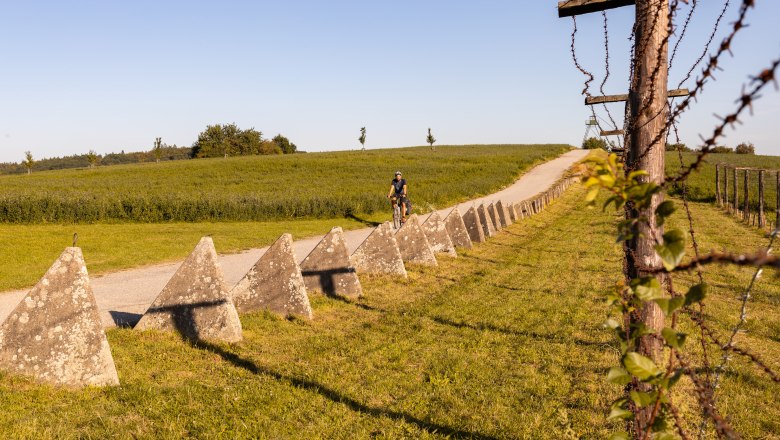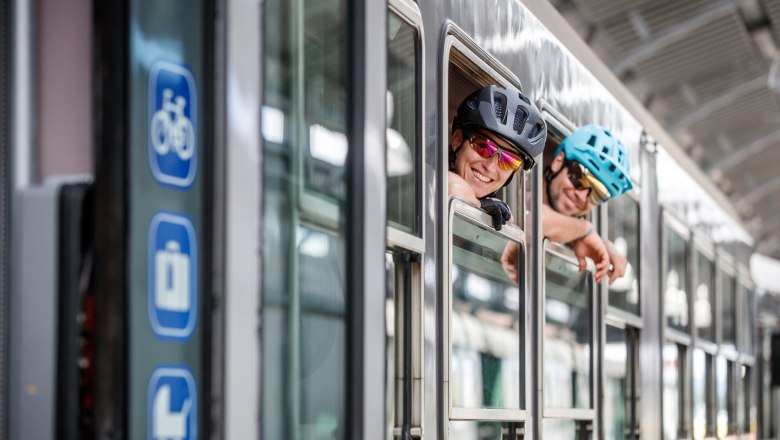Boundless search for traces
The Iron Curtain Trail, a cycle path between two countries, which starts in Gmünd and follows the traces of the past. Harald Winkler knows the border history(s).
Eight times from Gmünd to Retz. This is how often cyclists switch between Austria and the Czech Republic on the Iron Curtain Trail. Where the Iron Curtain once stretched, today you can learn a lot about both countries and the history that unites them while cycling.
"Cycling here in the northern Waldviertel really is a beautiful story", says Harald Winkler enthusiastically. Simply because of the unique flora and fauna of the Green Belt along the trail - at the Blockheide Nature Park, at the Trebonsko UNESCO Biosphere Reserve or at the Thayatal National Park - and especially because the trail is so steeped in history. Winkler thinks about this when he talks about places along the Iron Curtain Trail. He devotes more time to their stories and contemporary history than to cycling itself. Winkler is a Gmünder who, as he says, "grew up with the European mood of cross-border cooperation".


Born in 1989 at the time of the fall of the Iron Curtain, the aftermath of the border opening still preoccupies him today, 34 years later. He has already written a few books chronicling the area with which he has family and professional roots. Winkler is responsible for public relations for the municipality and is a curator at the House of Contemporary History in Gmünd. And he also knows exactly how historically interwoven Austria and the Czech Republic are in this border region: "These were always two areas that belonged together". Even though he is rarely on his bike, the city historian knows his way around the past starting in Gmünd - and reveals significant places.
History to attack
You don't have to cycle far to get to the first special features. Already in Gmünd, the starting point of the first stage of the Iron Curtain Trail, the history is so condensed that you can safely park your bike and explore the surroundings. You can start indoors before cycling to get some fresh air: In the House of Contemporary History, the permanent exhibition tells the story of the border and shows how the place has changed since the opening of the Franz-Josefs-Bahn. "Gmünd makes history tangible", says Winkler, adding that this is also true outside the museums - especially in Bleylebenstraße. There, the border once separated the town from neighbouring České Velenice in the Czech Republic. Today, you can easily cross the connecting bridge over the border river Lainsitz. And so it is not only history that can be seen here pictorially, but also "how the separate past has become a common present again," Winkler emphasises, becoming almost rapturous: "The bridge is symbolic of the cooperation between the two cities, which works wonderfully - from practical things like a joint emergency water supply, the health and education sectors to culture"

The disappeared becomes visible
The once insurmountable Cold War barrier has almost completely disappeared today. Only a few original rusty signs with the inscription "Achtung Staatsgrenze" (“Attention! National Border”) can still be found at the roadside. At Bleylebenstraße, a piece of the Iron Curtain was reconstructed as a place of remembrance. "Now you have something to show off", says Winkler about the new memorial. If you continue over the bridge from here, you will come across the old railway station of Gmünd in the Czech Republic. This is also the starting point of the "Zeitge(h)schichte zweier Städte" (History of Two Cities) theme trail, which Winkler recommends to passers-by. It is another special place that makes the bond of yesteryear visible.
It is precisely this visualisation that the cultural association "Transitions - Přechody” has set itself, which celebrates the interfaces between Eastern and Western Europe with a festival in July - and invites visitors to a new form of history education with augmented reality excursions: By means of a mobile phone app, you can search for ten places where border stories and former buildings are virtually set up in front of you. "As the municipality of Gmünd, we support the project with two researched escape stories", explains Winkler. Of course, all these paths can be cycled. And when you're already pedalling, it's best to keep going: the historical places that these paths touch on continue along this unique route, and so the following cycle stages take you deep into the history of Europe.
Free and outdoors
So once you've set off from Gmünd, after a few border crossings and kilometres you'll be rewarded with authentic remnants of the Cold War and extraordinary locations - an outdoor history tour, all for free. After just two stages, you arrive at the decommissioned border control at Fratres/Slavonice, and come across the huge fence art installation "Wohin verschwinden die Grenzen?” (“Where are the borders disappear to?") by Iris Andraschek & Hubert Lobnig. Four metres high and fifty metres long, the metal construction is enthroned at the top with the eponymous lettering - another tip from Winkler for a place where demarcation and opening are visible. Reconstructed relics can also be found in the walk-in bunker complex in Slavonice. Add a few more kilometres of cycling and you reach one of the rare places near Čížov, where remnants of the Iron Curtain, barbed wire fences and watchtowers have been preserved.

Winkler has one last piece of advice for those who are managing their strength on the Iron Curtain Trail there. You can take your bike with you for a few kilometres on the Waldviertel train, making the trail search easier. After all, here you are cycling along the longest cycle path in Europe.